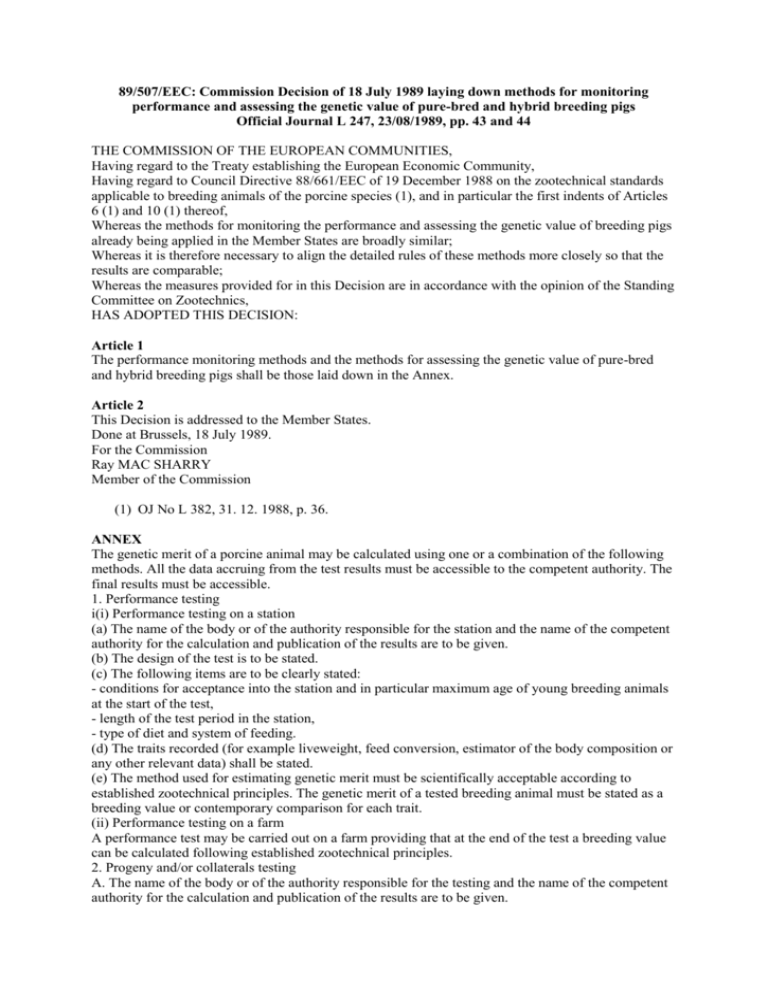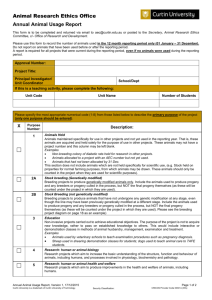eur49568
advertisement

89/507/EEC: Commission Decision of 18 July 1989 laying down methods for monitoring performance and assessing the genetic value of pure-bred and hybrid breeding pigs Official Journal L 247, 23/08/1989, pp. 43 and 44 THE COMMISSION OF THE EUROPEAN COMMUNITIES, Having regard to the Treaty establishing the European Economic Community, Having regard to Council Directive 88/661/EEC of 19 December 1988 on the zootechnical standards applicable to breeding animals of the porcine species (1), and in particular the first indents of Articles 6 (1) and 10 (1) thereof, Whereas the methods for monitoring the performance and assessing the genetic value of breeding pigs already being applied in the Member States are broadly similar; Whereas it is therefore necessary to align the detailed rules of these methods more closely so that the results are comparable; Whereas the measures provided for in this Decision are in accordance with the opinion of the Standing Committee on Zootechnics, HAS ADOPTED THIS DECISION: Article 1 The performance monitoring methods and the methods for assessing the genetic value of pure-bred and hybrid breeding pigs shall be those laid down in the Annex. Article 2 This Decision is addressed to the Member States. Done at Brussels, 18 July 1989. For the Commission Ray MAC SHARRY Member of the Commission (1) OJ No L 382, 31. 12. 1988, p. 36. ANNEX The genetic merit of a porcine animal may be calculated using one or a combination of the following methods. All the data accruing from the test results must be accessible to the competent authority. The final results must be accessible. 1. Performance testing i(i) Performance testing on a station (a) The name of the body or of the authority responsible for the station and the name of the competent authority for the calculation and publication of the results are to be given. (b) The design of the test is to be stated. (c) The following items are to be clearly stated: - conditions for acceptance into the station and in particular maximum age of young breeding animals at the start of the test, - length of the test period in the station, - type of diet and system of feeding. (d) The traits recorded (for example liveweight, feed conversion, estimator of the body composition or any other relevant data) shall be stated. (e) The method used for estimating genetic merit must be scientifically acceptable according to established zootechnical principles. The genetic merit of a tested breeding animal must be stated as a breeding value or contemporary comparison for each trait. (ii) Performance testing on a farm A performance test may be carried out on a farm providing that at the end of the test a breeding value can be calculated following established zootechnical principles. 2. Progeny and/or collaterals testing A. The name of the body or of the authority responsible for the testing and the name of the competent authority for the calculation and publication of the results are to be given. B. The genetic merit of the breeding animal is to be calculated by assessing the qualities of a suitable number of progeny and/or collaterals in relation to production characteristics: - a detailed description of the test method must be given or quoted, - the progeny and/or the collaterals may not be selectively treated, - three types of progeny and/or collaterals tests are to be recognized: (a) central testing in progeny and/or collaterals testing station; (b) planned progeny and/or collateral testing in a farm. The progeny and/or the collaterals should be distributed amongst herds in such a way that a valid comparison between breeding animals is possible; (c) data collected on identified progeny and/or collateral carcases. C. The progeny and/or collaterals must be chosen in an unbiased manner. All relevant data must be used in assessing the breeding value of the breeding animals. Influences other than the genetic merit must be eliminated by appropriate procedures in the determination of the breeding value. D. The traits recorded (for example liveweight gain, feed conversion, carcasequality, reproduction characteristics, fertility, prolificity, viability of the progeny and/or collaterals or any other relevant data) must be stated. E. The method used for estimating genetic merit must be scientifically acceptable according to established zootechnical principles. 3. Contemporaries testing for the breeding animals of hybrid lines The conditions applicable to the progeny and/or the collaterals, defined in paragraphs A, B, C, D and E of point 2, are to apply mutatis mutandis to contemporaries of breeding animals of hybrid lines.




